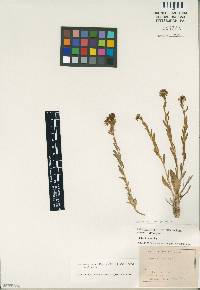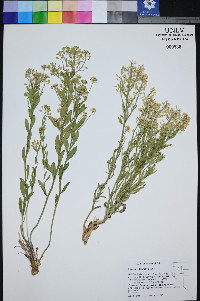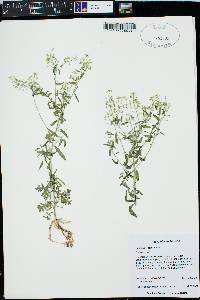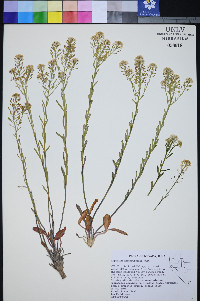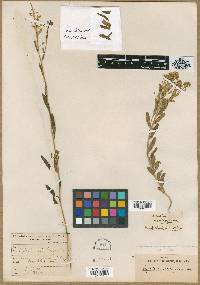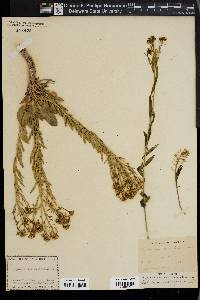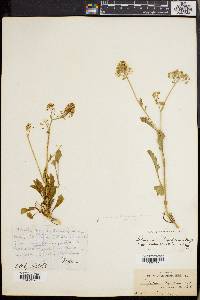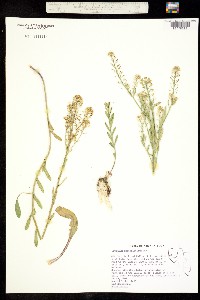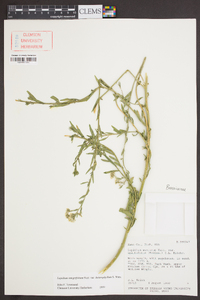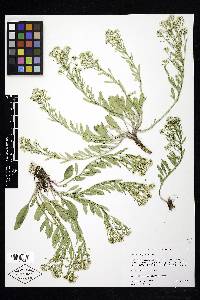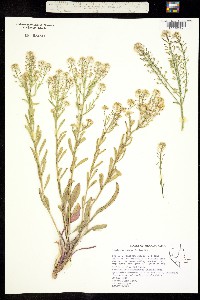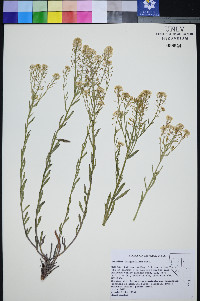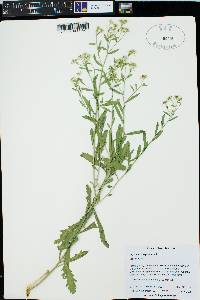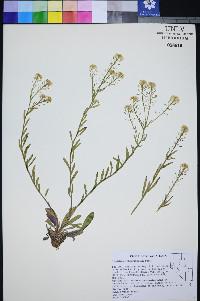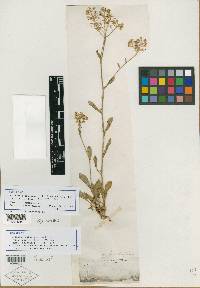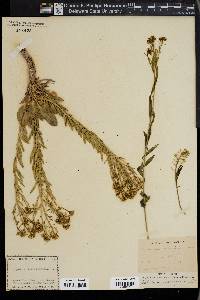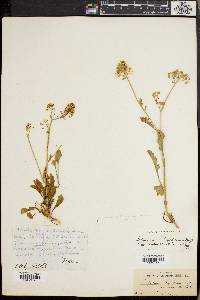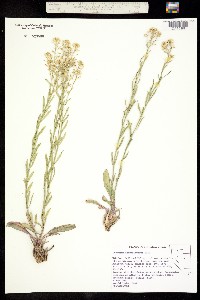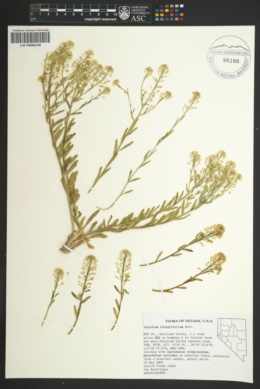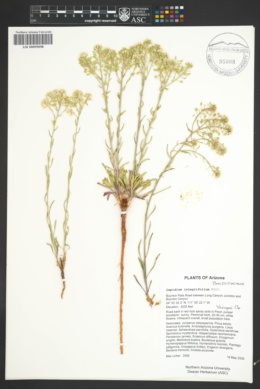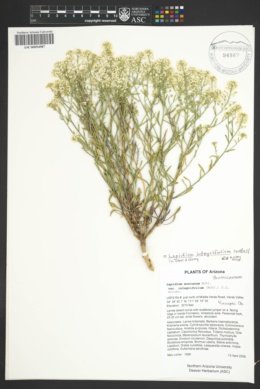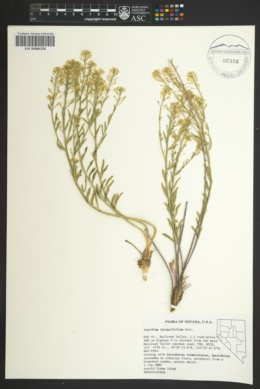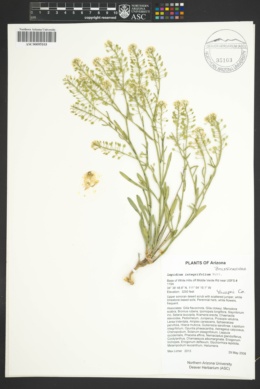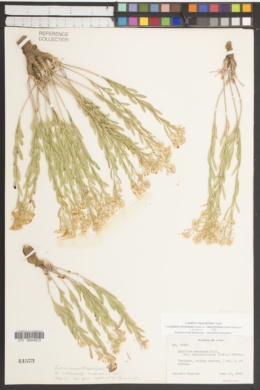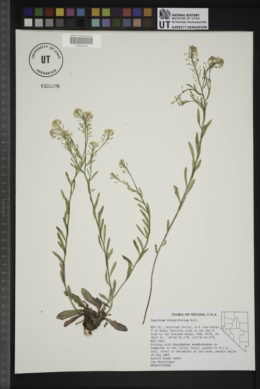Lepidium integrifolium
|
|
|
|
Family: Brassicaceae
Thick-Leaf Pepperwort, more...thickleaf pepperweed
|
Perennials; (caudex often thick, not aboveground, covered with persistent petiolar remains); puberulent. Stems several from base (caudex), ascending, branched distally, (1-)1.5-3.5(-4) dm. Basal leaves rosulate; petiole (0.5-)1.5-6(-7.5) cm; blade oblanceolate to obovate, (1.5-)2.5-7(-9) cm × (10-) 15-25 mm, margins usually entire, rarely denticulate subapically. Cauline leaves shortly petiolate or sessile; blade narrowly lanceolate to broadly oblanceolate, 1-5 cm × 2-9(-12) mm, base cuneate, not auriculate, margins usually entire, rarely denticulate subapically. Racemes elongated in fruit; rachis puberulent, trichomes straight, sometimes clavate. Fruiting pedicels divaricate-ascending to horizontal, straight, (not winged), (4-) 5-10 × 0.3-0.5 mm, puberulent adaxially. Flowers: sepals oblong-obovate, (1.5-)1.8-2.5 × 0.8-1.3 mm; petals white, obovate, (2.3)2.5-3.6(-4) × 1.5-2.2 mm, claw 0.5-1 mm; stamens (2 or) 4 (or 6), median and lateral when 4, (erect); filaments 1.7-2.5 mm, (glabrous); anthers 0.5-0.8 mm. Fruits ovate, (3-)3.2-4(-4.4) × 2-3.5 mm, apically winged, apical notch 0.1-0.3 mm deep; valves thin, smooth, not veined, glabrous; style 0.5-0.8(-1) mm, exserted beyond apical notch. Seeds ovate, 1.8-2 × 0.9-1.1 mm. Flowering Jun-Jul. Alkaline and saline meadows; of conservation concern; 1300-2000 m; Ariz., Nev., Utah, Wyo. The circumscription of Lepidium integrifolium is somewhat controversial. C. L. Hitchcock (1936) treated it as two varieties or (Hitchcock 1950) two subspecies of L. montanum, whereas R. C. Rollins (1993) treated it as a distinct species with two varieties. Rollins indicated that the species has two stamens, but such occurrence is rather rare. Most commonly, it has four stamens and is readily distinguished from related species by having four nectar glands and sepals sparsely pubescent subapically with crisped trichomes. Nothing is known about the populational variation of stamen number in the species and whether one or more taxa are involved.
FNA 2010, Kearney and Peebles 1969, McDougall 1973 Duration: Biennial Nativity: Native Lifeform: Subshrub General: Herbaceous biennials to perennials, 10-40 cm tall, stems several from the caudex of the base, ascending and branching distally, herbage puberulent to glabrous, with a thick caudex, often not aboveground, usually covered with persistent petiolar remains. Leaves: Alternate, basal and cauline; basal leaves petiolate and forming a basal rosette, blades oblanceolate to obovate, 1.5-9 cm long and 10-25 mm wide, margins usually entire, rarely denticulate subapically, petioles 0.5-7.5 cm long, cauline leaves shortly petiolate or sessile, narrowly lanceolate to broadly oblanceolate, 1-5 cm long and 2-12 mm wide, bases cuneate, without auricles, margins usually entire or rarely denticulate subapically. Flowers: White, with 4 petals forming a cross, petals obovate, 2-4 mm long and 1.5-2 mm wide, claws 0.5-1 mm long, sepals 4, free, oblong-obovate, 1.5-2.5 mm long and to 1.3 mm wide, stamens 2 or 4 or 6, median and lateral erect when 4 are present, filaments glabrous, 1.5-2.5 mm long, anthers 0.5-1 mm long, ovary solitary and superior, generally 2-chambered with a septum connecting 2 parietal placentas, styles solitary, 0.5-1 mm long, stigmas entire or 2-lobed, flowers borne in elongated racemes at branch tips, rachis puberulent with straight, sometimes clavate trichomes. Fruits: Ovate siliques dihescent into 2 valves and a septum, 3-4.5 mm long and 2-3.5 mm wide, apically winged, apical notch 0.1-0.3 mm deep, valves thin, smooth, glabrous and not veined, style persistent and exserted beyond apical notch, fruiting pedicels not win Ecology: Of conservation concern, found in alkaline and saline meadows, from 4,500-6,500 ft (1372-1891 m); flowering June-July. Distribution: Arizona, Nevada, Utah, Wyoming. Ethnobotany: Specific uses for this species are unknown, but other species in the genus have uses; tender plant and roots eaten as potherbs. Synonyms: Lepidium integrifolium var. integrifolium Editor: LCrumbacher2012 Etymology: Lepidium comes from the Greek lepidion, meaning "a little scale," in reference to the shape of the fruit pods, and integrifolium indicates that the leaf margins are entire, uncut, not toothed. |








